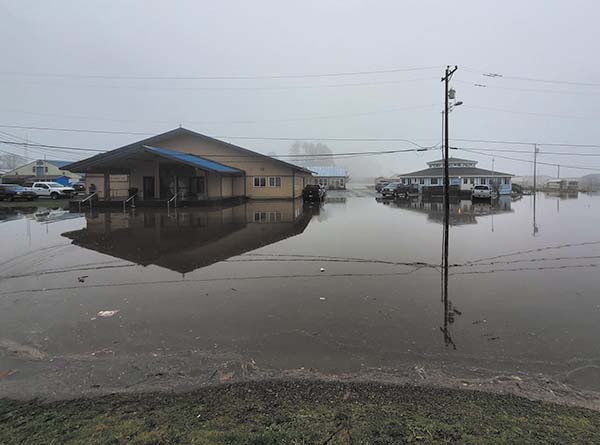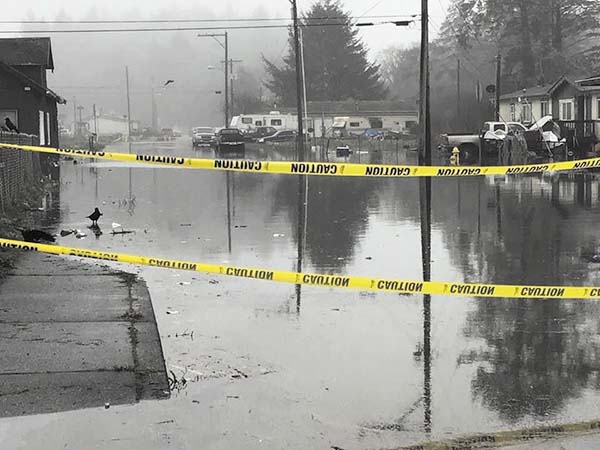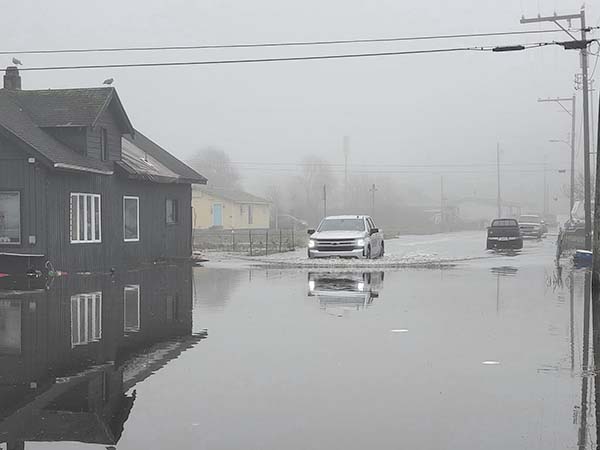
By Kalvin Valdillez, Tulalip News; photos by Jeff Eison and Shelley McCrory
The mouth of the Quinault River holds a special place in the heart of every single tribal member of the Quinault Indian Nation (QIN) – and that is no exaggeration. A photo of the river alone can evoke memories of adolescence, whether that is celebrating Chief Taholah Days during each fourth of July weekend, swimming with your cousins in the summertime, or harvesting delicious blueback sockeye salmon from its waters. Long before the days of colonialism, the ancestors of the Quinault people lived and harvested along the banks of the river. And to this day, nearly two hundred households, approximately seven hundred people total, still call the Indigenous village that leads to the ocean, home.
Present day Taholah can be divided into two sections; the lower village and the upper village (more commonly known as Snob Hill). The upper village consists of a handful of homes, the Roger Saux Health Center and the Tribal administration office. These facilities are relatively new as many of the buildings were established in the 80’s and 90’s due to a need for expansion for the growing tribe. However, during QIN’s early days of self-governance, all tribal operations were located in the lower village and the tribal office itself had quite the view of the mouth of the Quinault River.
In addition to the many families that occupy the lower village, several departments and businesses still operate near the river including the Quinault Cultural Museum, Quinault Enterprises (a.k.a. the fish house), the Taholah Mercantile, the post office, the community center, the police department, the Nugguam (QIN newspaper), as well as the senior center, shaker church, daycare, head start and the K-12 tribal school. Generation after generation, Quinaults spent their youth learning about their lifeways, traditions and culture, largely centered around the lower village and the Quinault River.
The Quinault River feeds into the Pacific Ocean and during the 70’s, the Nation installed a seawall extending along the coastline for about a half a mile and roughly ten-feet tall, protecting the town of Taholah from the unpredictable, powerful, and often times dangerous waters of the sea. This proved to be an effective solution to the threat of flooding during high tide and stormy weather. That is until 2014 when the ocean breached the seawall and excessive water poured into the lower village, causing water damage to many homes and establishments.

The Quinault River feeds into the Pacific Ocean and during the 70’s, the Nation installed a seawall extending along the coastline for about a half a mile and roughly ten-feet tall, protecting the town of Taholah from the unpredictable, powerful, and often times dangerous waters of the sea. This proved to be an effective solution to the threat of flooding during high tide and stormy weather. That is until 2014 when the ocean breached the seawall and excessive water poured into the lower village, causing water damage to many homes and establishments.
The Nation made an emergency declaration and the U.S. Army Corps of Engineers answered the call, assisting the tribe with repairs to the ruptured seawall. That incident also forced the Tribe to consider relocating the entire lower village to higher ground and out of harm’s way, from both the inundation of the Quinault River and the possibility of a tsunami as Taholah is located on the Cascadia subduction zone.
Since then, QIN created a master plan to relocate the lower village and even began clearing land and constructing a select few buildings of the new village, the very early stages of a 25-year plan. Ideally, the Nation would like to get everybody uphill as soon as possible, but they have been met with a number of challenges such as funding. The original masterplan estimated the total cost of relocation right around $65 million.
Although many QIN tribal members agreed that relocation is probably the best solution, several families expressed that they simply would not leave their homes when it came time to relocate, and perhaps deemed the threat of extreme flooding too far ahead in the future.
The 2014 flood was attributed to climate change, a result of sea-level rise. Rising sea-level is a complex topic that will in time impact the entire planet. Like Taholah, many towns and major cities across the world will experience severe flooding, and in some extreme cases they could be underwater completely. Scientist and environmentalists predict that sea-level will continue to rise at about its current rate until around the year 2050, and then will start to accelerate at even a faster pace after that.
Since the Industrial Revolution in the 1800’s, the Earth has been rapidly heating up due to the excessive burning of fossil fuels and the production of greenhouse gases. As the planet traps those emissions in its atmosphere, the warmer Earth gets. And as a direct result of global warming, the amount of water in the ocean is increasing because as water heats, it expands. Another contributing factor to sea-level rise are the melting ice caps.
“Sea-level has risen eight or nine inches in the last hundred years and it’s accelerating,” said Phillip North, Tulalip Natural Resources Conservation Scientist. “Since global warming is happening faster than we expected, the water is getting warmer faster and expanding. We’re getting more sea-level rise than expected. Plus, the warmer ocean is melting the ice faster. Greenland is melting faster, Antarctica is melting faster, all the continental glaciers; everything’s melting faster than we expected. We’ll see a pretty steady progression up until the middle of the century and then it will start to speed up.”
Almost seven years later, amid a worldwide pandemic, ocean waters encroached the lower village of Taholah once again on the morning of January 12. Following a stormy PNW night, that cut out the lights on the Tulalip reservation, the ocean surge met with high tide causing the Quinault river to swell, allowing even more ocean water to enter the village than the 2014 flood. QIN Interim Emergency Coordinator and volunteer firefighter, Desiree Markishtum, explained that they were prepared and prepped 200 sandbags the night prior in case the water threatened to flood the village. However, not many could predict the amount of flooding and water damage that would ensue that morning.

“On January 12, high tide was expected around 11:00 (a.m.),” she stated. “I received an email from Bob Shale in Utilities Maintenance at 11:23 stating that his department would be needing a lot more sandbags and that the water was coming in fast. His office building is located on the end of First Ave. Immediately afterwards I received a call from [QIN COO] Andrea Halstead asking that I get an eye on that as soon as possible. I showed up on scene to see our ambulance’s, and other first responder vehicles, tires about 1/8 of the way underwater which is unusual.
She continued, “next I see Lisa Hall, the Nation’s lead paramedic, about mid-shin in the water observing the scene. At 11:53, I was given the orders to evacuate the residents of First Ave by Chief of Police, Mark James, and began evacuating the most vulnerable, our elders and our children. At that time, public safety began the evacuation of Pine and Cedar Street, both impacted by the flood as well. Evacuees were placed at the Quinault Beach Resort and Casino in Ocean Shores and at the Ocean Crest in Pacific Beach until conditions were safe, which was two days total.”
Once again, QIN declared a flooding emergency and released a statement claiming that the excessive water inundated the tribal police station, court house, multiple homes and essential infrastructure. The statement also warned the tribal membership of the possibility of landslides on the only safe and reliable road out of Taholah, SR-109, that could prevent or hinder evacuation efforts.
“As a tribal member it was a very scary feeling seeing so many homes being impacted by the flooding,” expressed QIN Tribal member, Tootie James. “Desiree Markishtum, current acting emergency management coordinator, did an awesome job evacuating the elders and community members in need. I brought my mom, a tribal elder, for a ride around the village after the storm. She said she’s never seen anything like it before. The flooding has never been this bad.”
With lower village residents safely evacuated, QIN was not in the clear just yet. With much of the town still covered in about a half-a-foot of water, the Nation still needed to prepare for yet another challenging day as a king tide was set to make an appearance the following morning.
Said Tootie, “the Tribe issued leave time for [employees] to utilize work-hours to fill sandbags so we would be ready. There was probably about fifty or more people filling empty sandbags working to beat the tide. By the time we were finished, it was almost noon and the tide had already pushed us back. For me it was really scary being around a large group of people due to COVID, but it felt like it was work that needed to be done.”
Added Desiree, “coming from a close community like Taholah, a big thing to take away from this event is the importance of knowing your community, what their capabilities are, and also knowing their needs.”
After a great show of community, QIN President Fawn Sharp issued a statement to Quinault membership and expressed, “On behalf of the Quinault Business Committee, we want to publicly thank all those who stepped up to help in our moment of disbelief as we all witnessed the ocean breach into our village. The line of volunteers who dropped everything to answer our call to action to fill sandbags was a testament to our strength, resiliency, and love for each other. No matter how crazy the outside world becomes, there’s one thing for certain – in times of need and emergency, we are Quinault Strong, always have been and always will be.”
President Sharp also shared that the U.S. Army Corps of Engineers were on their way to the reservation to assess the damage of the village, while also calling on ‘federal and state partners to work with [QIN] to better prepare for inevitable future flooding’.
QIN tribal member, Nancy Underwood, lives in the lower village and was evacuated the day of the flood. She stated that luckily there was no structural damage to her home, but it did cause damage to her plumbing and electrical systems. And if there was any skepticism about relocation before this event, she now sees the idea in a whole new light.
“It was an eye opener for sure,” Nancy exclaimed. “It gave us all a real fear of the elements. We are now in emergency preparedness mode and wondering what the next storm has in store for us. This most certainly gave us a greater respect for Mother Nature, our family and belongings. After that experience and how fast everything happened, I firmly would relocate my family. You can replace material things, but you can’t replace your family had something worse happened.”
For now, QIN is continuing with their relocation master plan that places their membership and residents of the lower village 120-feet above sea level, out of the tsunami flood hazard zone. With the recent declaration of disaster caused by the tribe’s largest flooding catastrophe to date, hopefully the Nation can now find additional funding to help speed-up the process of relocation to ensure the safety and well-being of the tribe’s membership and future generations.
“Our tribe is currently working as fast as they can to move the village to higher ground,” explained Tootie. “There are plans for new homes; the senior center, daycare and head start are going to be opening soon so they will be safe from flooding and out of the tsunami zone. It’s a hard but necessary decision for people to leave their homes and move to higher ground.”